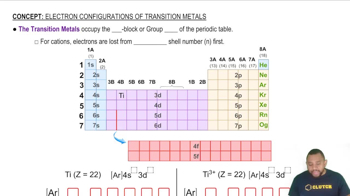Here are the essential concepts you must grasp in order to answer the question correctly.
Electron Configuration
Electron configuration describes the distribution of electrons in an atom's orbitals. For transition metals, this involves filling the 3d and 4s orbitals. Understanding the electron configuration is crucial for determining the number of valence electrons in transition metal ions, especially when they lose electrons to form cations.
Recommended video:
Electron Configuration Example
Valence Electrons
Valence electrons are the outermost electrons of an atom and are involved in chemical bonding. In transition metals, the valence electrons include those in the s and d orbitals. Identifying the number of valence electrons in transition metal ions helps predict their chemical behavior and reactivity.
Recommended video:
Transition Metals Valence Electrons
Transition Metal Ions
Transition metal ions are formed when transition metals lose electrons, typically from their outermost s and d orbitals. The charge of the ion affects the electron count in these orbitals. Understanding how to determine the electron count in the d orbitals of these ions is essential for solving the given problem.
Recommended video:

 Verified step by step guidance
Verified step by step guidance

